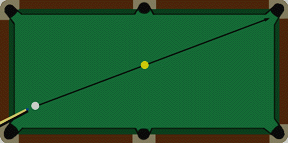Reassurance of sighting to aiming / locking in
Try this and see what works for you.
Set up a shot for 10:00 or 11:00 high left or right english. Put the tip there and take preliminary strokes but don't shoot. Stay in your ready position and have someone remove your cue from your hands. If you don't have anyone to assist you just go down on the shot without the cue stick. That is what you should be seeing, not the cue in your line of aim moving back and forth like a piston causing eye distraction, although many can play well this way.
Now try this.
Setting up the same shot place the tip at the base of the cue ball( bottom left or right not center ) and hold for a second or two. Now bring the stick up to where you want to hit, take your preliminary strokes and let it go. After you stroke thru let the stick drop softly on the table ( Dust Stroke ) This is the easiest way to see where you started and ended, also shows you if you went off line.
The Logic behind this taught to me when I was a kid from a few world champions who I would donate to on a regular basis.
When you stand over the shot you are looking down and sighting in.
When you go down your eyes are at a different angle/level.
You have to reassure what your eyes have seen when you were upright.
By dropping the stick at the base of the CB and holding you are reassuring your sighting ( It only takes a second )your stick is already be 99 - 100% in line when you dropped down. Near zero eye distraction
When you bring your stick up you are now aiming.
It's so easy to do, very simple and quick.
Sorry for the long rant or any confusion, I can teach this in 5 minutes.
Anyone I have ever taught this has said OMG it's so easy
It's not the holy grail of anything it is just so easy and quick, as you see many players do it, a very natural way to sight and aim, fluid and smooth.
There is more than one way to skin a cat, see what works for you.
